Felicia tenella subsp. tenella
Felicia tenella (L.) Nees subsp. tenella
Family: Asteraceae
Common names: bristly felicia (Eng.); astertjie (Afr.)
Introduction
This striking, winter- or spring-flowering annual with bright blue and yellow daisies, is another of South Africa’s plant jewels. It performs well in rockeries, pots and mixed, mass or border plantings.
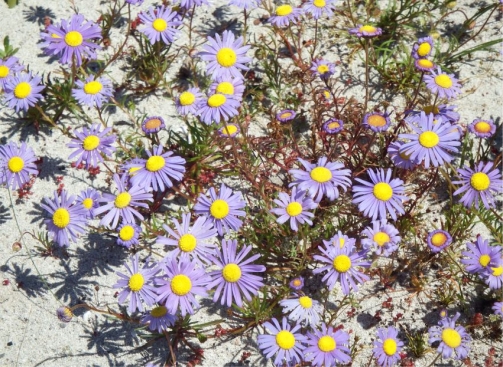
Description
Description
Felicia tenella subsp. tenella is a tender, erect or prostrate annual between 50 to 250 mm tall. The hairy, linear leaves are ericoid, 25 x 1 mm, with rough, bristly margins. A long, hairy stalk displays a single flowerhead, with yellow, bisexual, central disc florets and with either lavender, blue or white ray florets. The 5 mm wide involucre consists of 3 rows of overlapping, lance-shaped or inverted lance-shaped bracts. The bracts in the outer whorl are 3 mm long and 0.3 mm wide compared to those in the inner whorl which are 4 mm long and 1 mm wide. Flowering is in winter and spring, from August to October.
Serrated, white, deciduous pappus bristles, 2.5 mm in size, surround the corolla. The fruit is a cypsela, a dry, one-seeded, indehiscent fruit, darkish brown to black flattened, 1.5 mm in length and 0.5 mm in width, which can be harvested in late spring, from October to November.
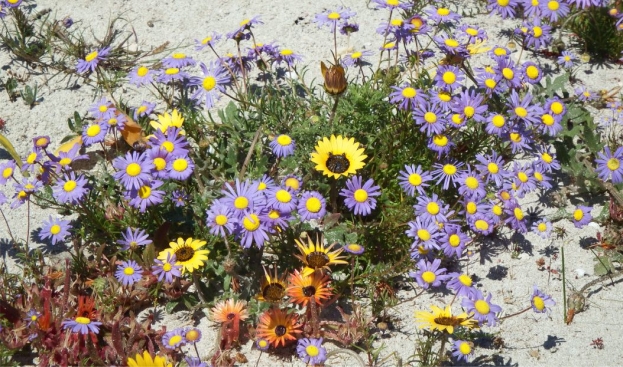
There are 4 subspecies of Felicia tenella: subsp. tenella, subsp. cotuloides, subsp. longifolia and subsp. pusilla. The subsp. cotuloides is a smaller, much-branched plant, up to 200 mm tall, with smaller flowers, some as small as 2 mm in diameter. The subsp. pusilla is also a smaller plant, up to 200 mm tall, sparsely branched, with flowers smaller than those of subsp. tenella, but larger than those of subsp. cotuloides. The subsp. longifolia is variable, has leaves up to 50 mm long, may have a woody base and live longer than a year, and roots at the nodes.
Conservation Status
Status
The conservation status of this widespread species is, according to the Red List of South African Plants website, regarded as one of Least Concern (LC).
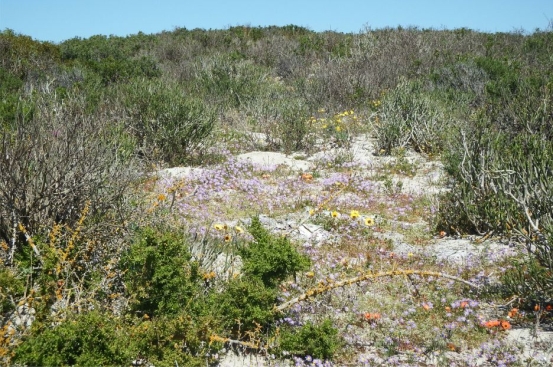
Distribution and habitat
Distribution description
Felicia tenella is common on sandy soils (coastal dunes) or moist sandy flats from Nieuwoudtville in the Northern Cape to Riversdale in the Western Cape.

Derivation of name and historical aspects
History
The generic name Felicia was given by the French botanist A.H.G. de Cassini (1781–1832) in 1818 but its derivation is uncertain. It may be named after Felix, a German official at Regensburg who died in 1846, or the name could be from the Latin word, Felix, which means ‘happy’ or ‘cheerful’ in reference to the normally cheery flowers of the genus. The species name tenella is Latin for ‘tender’ or ‘delicate’, which describes the nature of this species.
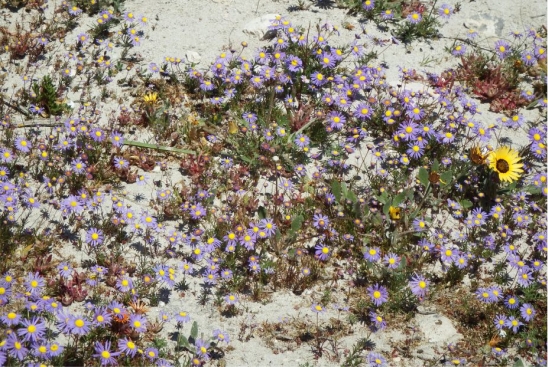
The genus Felicia is part of the daisy family, Asteraceae, the biggest plant family in southern Africa with approximately 2 500 species. Felicia, and several other well-known genera including Pteronia, Chrysocoma, Conyza and Amellus, fall under the Tribe Astereae. There are 302 species in this tribe. There are about 85 species of Felicia, widely distributed from southern to tropical Africa and Arabia. The majority of species are found in the 3 Cape provinces of South Africa.
Species of Felicia can often be mistaken for Garuleum, which differs in lacking bristles on its seeds and having finely divided leaves.
Felicias are relatively popular in ornamental horticulture, with the blue felicia bush (F. amelloides) already being introduced to Europe during the eighteenth century. The list of annuals, herbaceous perennials or shrublets till now, include popular species such as: F. filifolia (fine-leaved felicia), F. aethiopica (dwarf felicia or wild aster), F. australis (blue Karoo daisy ), F. heterophylla (true-blue daisy), F. echinata (prickly felicia) and F. erigeroides (wild Michaelmas daisy). F. erigeroides is also a popular medicinal plant in the Zulu culture.
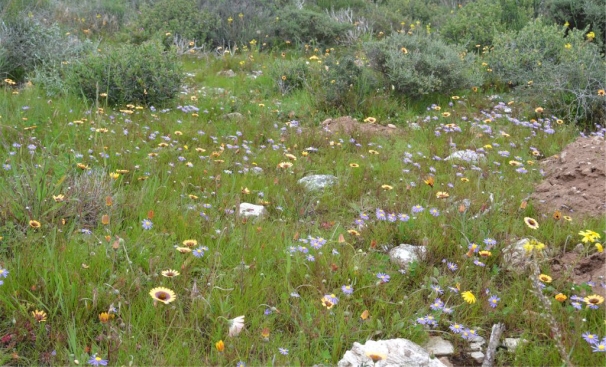
Ecology
Ecology
Bees, butterflies and other insects have been observed visiting this species and could possibly be involved with pollination.
Felicia tenella subsp tenella is an annual species. This means that its entire life-cycle, from germination, growing, flowering and going to seed, takes a single year till completion. Germination, for this late winter to spring-flowering species, occurs in the autumn, when ample moisture becomes regularly available, in the form of rain and the weather becomes cooler.
Seeds may ripen from the middle towards the end of spring. This is also the period when the rain in its habitat becomes less regular. None of the dispersed seeds will germinate since the temperature will begin to rise and the availability of much needed moisture will become less common. The now rising temperatures, coupled with the lack of moisture will not induce germination. This species thus dodges the hot, dry summer months and survives the unfavourable conditions as ungerminated seeds in in the seed bank.
All florets possesses a pappus, the tuft of hair or a single row of stiff, small bristles. The pappus facilitates dispersal by acting as a parachute and thereby improving its chances of successful dispersal. A persistent or caducous pappus also provides protection to the cypsela while still in the involucre. The presence of bristles on the pappus is considered to be critically important in preventing secondary dispersal of seeds that have already reached the soil. These are just some of the features which enable Asteraceae to establish easily in arid regions.
In old flowers the involucre opens to leave the cypsela exposed. Normally very small and light, the cypsela become easily separated and are able to drift away by means of the parachute-like nature of the pappus.
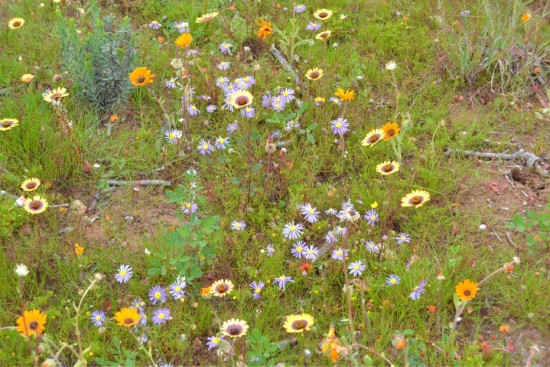
Uses
Use
There are no medicinal or cultural uses recorded for this species. Astertjies has huge potential as an ornamental. In the Klein Karoo-region several species of Felicia are palatable to stock and game.

Growing Felicia tenella subsp. tenella
Grow
Sow seeds in early to mid-autumn, in a well-draining medium. Ensure the medium is level, sow the seeds evenly, water gently and cover it lightly, with either fine-milled bark or sand. Prick the seedlings out from the trays or beds once they are large enough to be handled for planting out.
Felicia tenella subsp. tenella is a winner in mass mixed plantings with other annual species in small or larger flower beds, pots, rockeries or as border plantings.
In its natural habitat this species is seen growing with Ursinia anthemoides, Felicia elongata, Dimorphotheca tragus, Arctotis hirsuta, Arcthotheca calendula, Euphorbia mauritanica, Pelargonium fulgidum and Gazania krebsiana var. krebasiana.
Astertjies will also perform well with species such as: Cotyledon orbiculata, Ruschia macowanii, Pelargonium gibbosum, P. cucullatum and P. betulinum, Salvia aurea, Helichrysum dasyanthum, Arctotis stoechadifolia, Dimorphotheca sinuata and D. pluvialis, Cleretum bellidiforme, Heliophila coronopifolia, Carpanthea pomeridiana, Senecio littoreus, S.elegans and S. arenarius
This is a relative pest-free species with no known pests and diseases.
References
- Bean, A. & Johns, A. 2005. Stellenbosch to Hermanus. South African Wild Flower Guide 5. Botanical Society of South Africa, Cape Town.
- Goldblatt, P & Manning, J. 1996. West Coast. South African Wild Flower Guide 7. Botanical Society of South Africa, Cape Town.
- Jackson, W.P.U. 1990. Origins and meanings of names of South African plant genera. University of Cape Town.
- Koekemoer, M., Steyn, H.M. & Bester, S.P. 2015. Guide to Plant Families of southern Africa. Strelitzia 31. 2nd ed., 2nd print. South African National Biodiversity Institute, Pretoria, South Africa.
- Leistner, O.A. (ed.). 2000. Seed plants of southern Africa: families and genera. Strelitzia 10. National Botanical Institute, Pretoria.
- Foden, W. & Potter, L. 2005. Felicia tenella (L.) Nees subsp. tenella. National Assessment: Red List of South African Plants version 2020.1. Accessed on 2022/12/14
- Grau, J. 1973. Revision der Gattung Felicia (Asteraceae). Mitteilungen der Botanischer Staatssammlung München 9: 195–729.
- Le Roux, A. & Schelpe, T. 2005. Namaqualand. South African Wild Flower Guide 1. 3rd ed. Botanical Society of South Africa, Cape Town.
- Lucas, N. 2009. Felicia erigeroides. PlantZAfrica. Online. http://pza.org/felicia-erigeroides.
- Manning, J. & Goldblatt, P. 2012. Plants of the Greater Cape Floristic Region 1: the Core Cape Flora. Strelitzia 29. South African National Biodiversity Institute, Pretoria.
- Smithies, S.J. 2005. Felicia amelloides. PlantZAfrica. Online. http://pza.org/felicia-amelloides.
- Van Rheede Van Oudtshoorn, K. & Van Rooyen, M. 1999. Dispersal Biology of Desert Plants. Springer-Verlag, Berlin.
- Riley, H.P. 1963. Families of flowering plants of southern Africa. University of Kentucky Press, Kentucky.
- Stearn, W. 2002. Stearn's dictionary of plant names for gardeners. Timber Press, Portland, Oregon.
- Trinder-Smith, T.H. 2003. The Levyns Guide to the plant genera of the south western Cape. Bolus Herbarium, UCT, Red Roof Design CC, Cape Town
- Trinder-Smith, T.H. 2006. Wild flowers of the Table Mountain National Park. Associated Printing, ??? .
- Vlok, J. & Schutte-Vlok, A-L. 2015. Plants of the Klein Karoo. Umdaus Press, Hatfield.
Credits
Roger Oliver
Kirstenbosch National Botanical Garden
December 2022
Plant Attributes:
Plant Type: Bi/Annual
SA Distribution: Northern Cape, Western Cape
Soil type: Sandy, Loam
Flowering season: Spring
PH: Acid, Neutral
Flower colour: Blue, White, Yellow
Aspect: Full Sun
Gardening skill: Easy
Special Features:
Horticultural zones









Rate this article
Article well written and informative
Rate this plant
Is this an interesting plant?
Login to add your Comment
Back to topNot registered yet? Click here to register.